Out of every piece of equipment you can find in a gym, you’ll be hard-pressed to find a more versatile tool than the barbell. Barbells are great tools for any fitness level and can be used for practically any form of lifting. If you’ve landed on this article, then you’re probably interested in taking your barbell training to the next level by investing and finding the best barbell for your lifting style, home gym, needs, and wants.
Similar to any other big gym equipment purchase, buying a barbell should be handled with care and attention. There are a ton of different barbells on the market, which can make it even harder find the best fit for your lifting needs. This best barbells round-up will aim to demystify some of the confusion that can come along with buying and shopping around for a new barbell.
Editor’s Pick

Fringe Sport Wonder Olympic Barbell
The Fringe Sport Wonder Olympic Barbell is an awesome barbell for every type of home gym athlete. This barbell has a strong 205,000 tensile strength, 160,000 yield strength, and durable black zinc outer coating. In addition, you can select bushings or bearings based on your preferred lifting wants and needs.
Why We Like the Fringe Sport Wonder Olympic Barbell
- Durable 205,000 tensile strength and 160,000 yield strength.
- Black zinc outer construction is rust and chip resistant.
- Quality knurling and bushing/bearing options available.

The Finge Sport Wonder Bar is an awesome barbell for the true beginner or elite home gym athlete.
Best for Everything
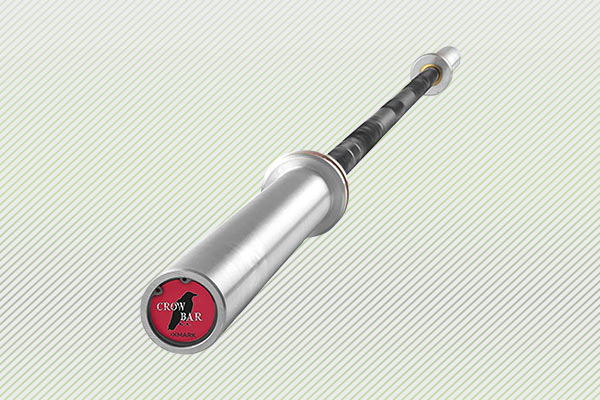
XMark Crowbar Olympic Barbell
The XMark Crowbar could be described as a “best of all worlds” type of barbell. This barbell has a strong 185,000 tensile strength, 1,500 lb testing, and black manganese coating for durability. The bushing offer adequate rotation, so if you love diverse training, then this barbell is a good bet.
Why We Like the XMark Crowbar Olympic Barbell
- Durable 185,000 tensile strength and 1,500 lb testing.
- Chip and rust resistant black manganese coating.
- Brass bushings offer quality rotation for all types of barbell movements.

Best Durability
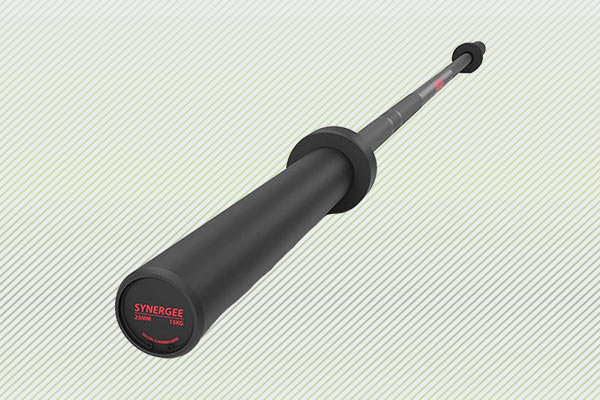
Synergee Games Colored Cerakote Barbell
The Synergee Games Colored Cerakote Barbell is one the best options for durability and cost efficiency. For starters, the cerakote finish provides this barbell with a strong chip and rust resistant outer construction. In addition, this barbell has a tensile strength of 190,000 and has been tested with up to 1,500 lbs.
Why We Like the Synergee Games Colored Cerakote Barbell
- Strong 190,000 tensile strength with testing up to 1,500 lbs.
- Chip resistant cerakote outer construction.
- Quality knurling and 10-needle bearings can withstand multiple tough gym sessions.
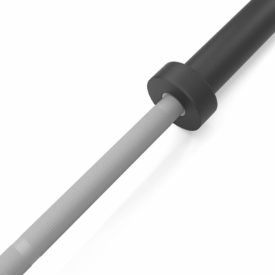
The Synergee Games Colored Cerakote Barbell has a durable 190,000 tensile strength and rust resistant cerakote finish.
Best Value
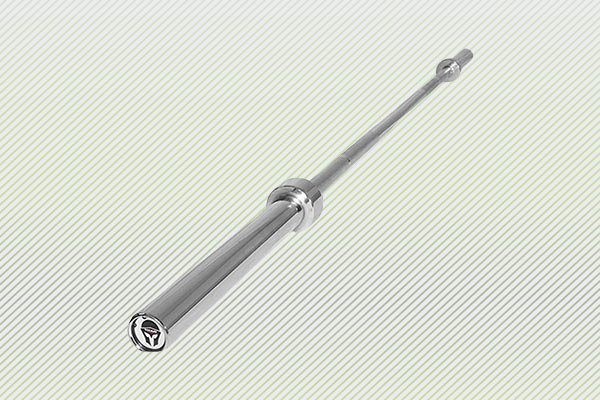
Titan Fitness Olympic Barbell
The Titan Fitness Olympic Barbell is a great cost efficient option for the recreational and hardcore fitness enthusiast. This barbell has been tested with weights up to 1,000 lbs and has a tensile strength of 165,000, so it comes with decent durability for the money.
Why We Like the Titan Fitness Olympic Barbell
- Strong 165,000 tensile strength for recreational use.
- Decent knurling across bar for promoting grip.
- Fits most plates, so it’s great in a variety of home gym settings.
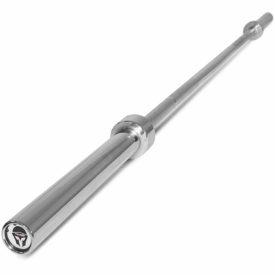
The Titan Fitness Barbell is a great cost efficient option for the recreational lifter that works out at home.
Best for Women

XMark Lumberjack Women’s Olympic Bar
The XMark Lumberjack Women’s Olympic Bar is a great bar for the home gym that loves to lift in multiple disciplines. This barbell has smooth bushings to support collar rotation for weightlifting and a knurling that closely shadows bars used in formal competitions. Additionally, manganese finish promotes long-term durability.
Why We Like the XMark Lumberjack Women’s Olympic Bar
- Durable and rust resistance manganese coating.
- Smooth rotating brass bushings accommodate for a variety of lifts.
- Tested at 700 lbs with no sign of deformation.

The XMark Lumberjack Olympic Bar features a black Manganese Phosphate Shaft, chrome sleeves, and has durability testing up to 700 lbs.
How We Assessed the Barbells
To help to take it a step further, we’ve included why and what beginner, intermediate, and advanced athletes may want to consider when assessing their perfect barbell’s construction. A barbell is a sizable investment that will last multiple years, so we want to make sure it lasts you a while, but also serves your needs best.
Types of Barbells
There are multiple types of barbells on the market, and for the beginning lifter or home gym owner it can be a little daunting when shopping around and seeing all of the options. In respects to major types of barbells, there are really three that are relevant to recreational lifters and strength athletes, and these include: Standard barbell, weightlifting barbell, and power bar.
These three barbells will each offer a different construction features to match specific needs. Below, we’ve quickly highlighted some of the main differences in the three major different types of barbells.
Knurling
The knurling on a barbell is the rigid, sandpaper-like texture that covers each side of the barbell and sometimes the middle. Knurling on a barbell is important for three major reasons. First, it promotes grip and can help improve lifting by allowing the barbell to remain still in the hands. Worn down knurling is more prone to rolling out of the hands during movements like rows and deadlifts.
Second, knurling is a useful tool for finding proper positioning on the bar. Each side of the barbell’s knurling will have a ring, sometimes two, and these can be useful for accurately finding hand and body positioning when trying to be centered on a barbell. Third, knurling can be supportive and strength-sport specific. For example, Olympic bars will have a smooth center knurling to avoid scratching the neck during cleans, and deadlift bars will have even more rigid knurling to promote grip.
- Beginner: A standard knurling will often benefit beginner or recreational athletes best, as it’s not incredibly rigid and too rough on the hands and it can help acclimate a newer athlete to what knurling feels like.
- Intermediate/Advanced: A standard or more rigid knurling will suit more advanced athletes best. By this point in one’s lifting career, more than likely they train in a certain way (strength sport), are slightly stronger, and know exactly what they’ll be getting if they opt for a more rigid barbell.
Knurling Tip: If you use chalk frequently when you’re working out, then make sure you brush down the knurling afterwards to promote the longevity of your barbell. Dirt and chalk can cause knurling to lose its rigidness over time if it gets permanently lodged into the grooves.
Barbell Grip Diameter
A barbell’s grip diameter can be an easily overlooked construction attribute that can be very important. The diameter of a barbell can be catered to one’s needs based off of preference, gender, and strength sport. The most common grip diameter for men’s barbells tends to be around 28mm-29mm and women’s are 25mm.
These are important diameters to remember because if you’re investing in a barbell, then you’ll want to use a barbell that you’ll be using in training and in competitive settings. And if you don’t compete, then simply knowing what could fit your hand’s needs best can help support your lifting.
Some barbells can vary even more than the most common grip diameters listed above, but we’d recommend considering sticking with what’s most commonly used. This will help promote carryover from training to competition, also, your barbell will feel like what most gyms offer, so there will be no awkward learning curve between your personal barbell and a gym’s “thick” bar.
Grip Diameter Tip: If you do, or plan to compete in weightlifting, powerlifting, or functional fitness, then check out your preferred federation’s rules so you can invest in the correct size barbell that they use in competition.
Barbell Strength
Tensile strength, yield strength, and test on a barbell can all be great suggestions for a barbell’s long-term durability, and can help highlight the likelihood of the barbell prematurely/resisting breaking and fracturing. All, or some of these attributes are listed by most barbell manufacturers, and we’d suggest straying from any company that isn’t willing to readily share their barbell’s details, as that could mean that their bar will be prone to quicker breakdown.
Tensile Strength: Out of the three attributes above, tensile strength is possibly the most important and widely used to highlight barbell strength/durability. This attribute entails how much your barbell can be loaded with before it breaks or fractures, aka high tensile strength = better barbell. Below, we’ve highlighted some general tensile strength guidelines.
- 150,000> — Decent for beginners, but it might be worth spending a bit extra to make your investment last.
- 150,000-180,000 — Good and suitable for most athletes.
- 180,000+ — Well constructed barbell that should last a long amount of time.
Yield Strength: This construction attribute entails how much weight can be loaded on a barbell before it becomes deformed. Have you ever lifted on a barbell that is shaped like a noodle? That is exactly what failed yield strength looks/feels like. A lot of companies don’t list their yield strength, but that’s not the biggest deal. This attribute can often be prevented by simply using good barbell practices (ex: not dropping a barbell on safeties with weight, etc), and high tensile strength often correlates with high yield strength.
Test: This construction attribute entails the documentation of how much weight a company has used to physically test the barbell. Some companies list the test of their barbell’s, and some don’t. If a company doesn’t list their barbell’s test, then make sure you look at tensile strength as these two can be very related.
Barbell Strength Tip: We didn’t include types of metals in this review, but paying attention to what materials companies use can be useful for also assessing a barbell’s strength and durability. Steel and chrome are the most common materials used in well-made barbells, and barbell coatings/finishes include things like steel, cerakote, and block oxide.
Whip
The whip of a barbell is the final construction aspect we’ll discuss before diving into our categories. Whip entails how much the bar will flex and give without losing its original shape. For the recreational and beginner lifter, this aspect isn’t a huge concern, but it becomes more important as athletes get deeper into their lifting careers and start competing.
Some companies will list how much whip their bars have, and most likely, these bars will have a specific purpose like weightlifting, deadlifting, squatting, and so forth. Below, we’ve included some general recommendations for different athletes considering a bar with whip.
- Beginner/Recreational Lifter: Standard whip is fine and will be best for every movement.
- Weightlifter: A bar with whip is useful for training, as this will closely resemble what’s used in competition.
- Powerlifter: Check out your federation’s rules. Deadlift-specific bars will have a lot of whip, which is great for pulling, but problematic in other movements. Power bars will be much more stiff and are used in federations like the USAPL.
Whip Tip: If you’re brand new to lifting, or you lift recreationally, then avoid worrying about whip when investing in a new barbell. Strength athletes — check out your federation’s rules!
FAQ
Q: I’m new to lifting, do I need an expensive barbell?
BarBend: That depends! If by expensive you mean high quality, then we’d ask this. Do you think you’ll become more invested in your training with time? If that’s the case, then it might be worth spending a little extra on a better barbell that will last longer. Basically, why buy a cheap barbell that will need to be replaced in a shorter amount of time?
Q: I’m a recreational lifter, what type of barbell should I get?
BarBend: If your only goal is to simply lift on a regular basis, then a standard barbell with bushings in the sleeves will work perfectly for you!
Wrapping Up
So, is the best barbell for you included in our list?
It very well could be. Perfect will be defined by what fits your lifting needs and wants best, and that’s in addition to fitting your budget. Barbells can be big investments, so leaving no stone unturned is the best route to take when you’re sinking money into a piece of equipment that has the ability to last for multiple years.
